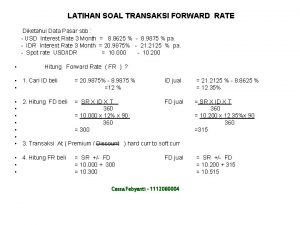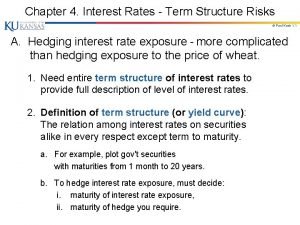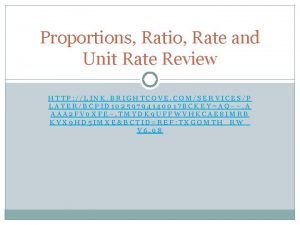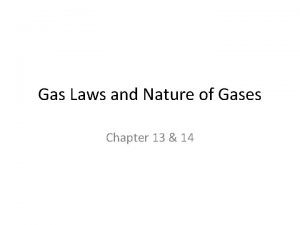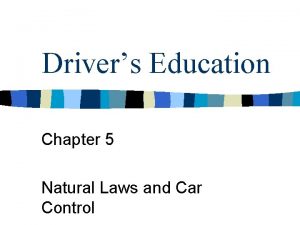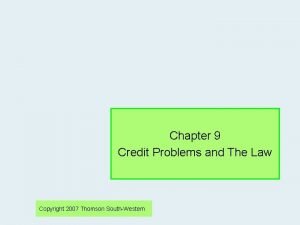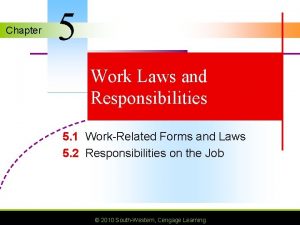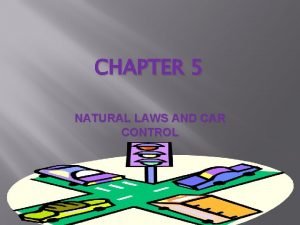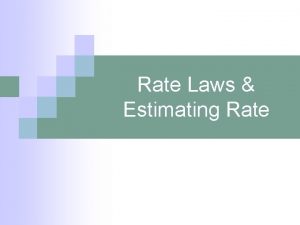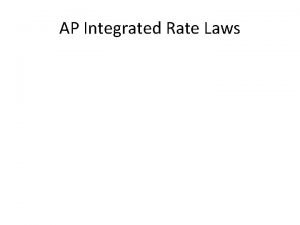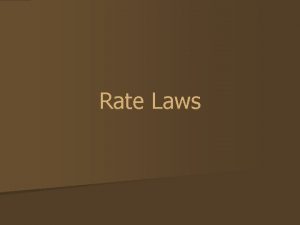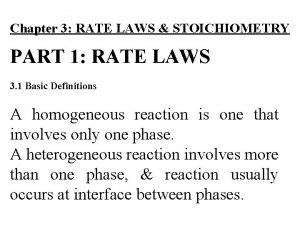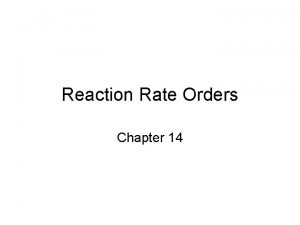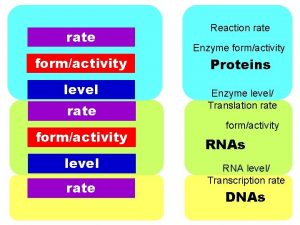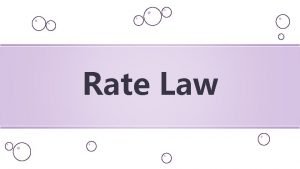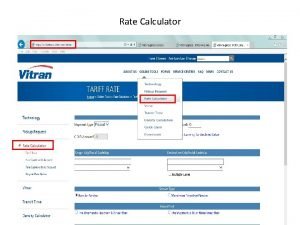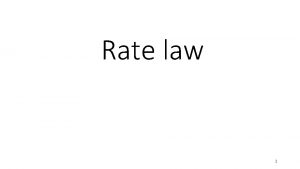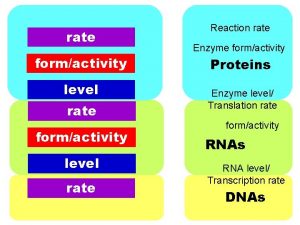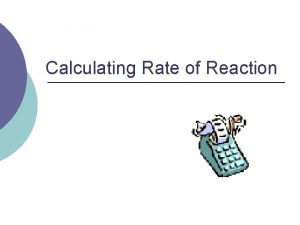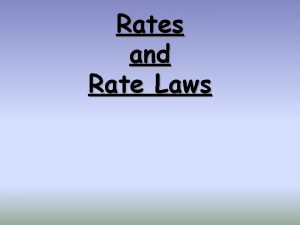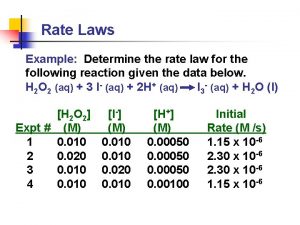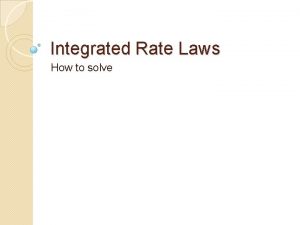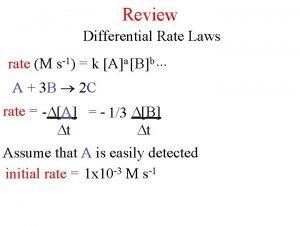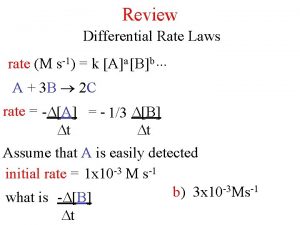Rate Laws Chapter 14 part II Rate Laws



![Integrated Rate Law • n Rate 1 = -∆[NO 2]/∆t Rate 2 = ∆[NO]/∆t Integrated Rate Law • n Rate 1 = -∆[NO 2]/∆t Rate 2 = ∆[NO]/∆t](https://slidetodoc.com/presentation_image_h2/194087d46688b2ece83d5e948b91bdff/image-4.jpg)

![Rate = k[NO 2 n ]= -∆[NO 2]/∆t Rate may be defined in different Rate = k[NO 2 n ]= -∆[NO 2]/∆t Rate may be defined in different](https://slidetodoc.com/presentation_image_h2/194087d46688b2ece83d5e948b91bdff/image-6.jpg)

![Defining Rate Laws n If Rate 1 = -∆[NO 2]/∆t = k[NO 2]n n Defining Rate Laws n If Rate 1 = -∆[NO 2]/∆t = k[NO 2]n n](https://slidetodoc.com/presentation_image_h2/194087d46688b2ece83d5e948b91bdff/image-8.jpg)




![Rate Laws: First Order [N 2 O 5] Rate M/s 0. 90 M 5. Rate Laws: First Order [N 2 O 5] Rate M/s 0. 90 M 5.](https://slidetodoc.com/presentation_image_h2/194087d46688b2ece83d5e948b91bdff/image-13.jpg)
![First Order Reactions n Rate = - ∆[A]/∆t = k[A] n Where A is First Order Reactions n Rate = - ∆[A]/∆t = k[A] n Where A is](https://slidetodoc.com/presentation_image_h2/194087d46688b2ece83d5e948b91bdff/image-14.jpg)

![For Example: NH 4+(aq)+NO 2 -(aq)-> N 2(g)+2 H 2 O(l) # [NH 4+]M For Example: NH 4+(aq)+NO 2 -(aq)-> N 2(g)+2 H 2 O(l) # [NH 4+]M](https://slidetodoc.com/presentation_image_h2/194087d46688b2ece83d5e948b91bdff/image-16.jpg)
![Determining a Rate Law # [NH 4+]M 1. 0. 100 2. 0. 100 3. Determining a Rate Law # [NH 4+]M 1. 0. 100 2. 0. 100 3.](https://slidetodoc.com/presentation_image_h2/194087d46688b2ece83d5e948b91bdff/image-17.jpg)
![NH 4+(aq)+NO 2 -(aq)-> N 2(g)+2 H 2 O(l) # [NH 4+]M [NO 2 NH 4+(aq)+NO 2 -(aq)-> N 2(g)+2 H 2 O(l) # [NH 4+]M [NO 2](https://slidetodoc.com/presentation_image_h2/194087d46688b2ece83d5e948b91bdff/image-18.jpg)



- Slides: 21

Rate Laws Chapter 14 part II

Rate Laws 2 NO 2(g) -> 2 NO(g) + O 2(g) n 2 NO(g) + O 2(g) -> 2 NO 2(g) n Rate 1 = -∆[NO 2]/∆t Rate 2 = ∆[NO]/∆t (-∆[NO 2]/∆t) -(∆[NO]/∆t n Chemical reactions are reversible. So far we have only considered the forward reaction in our rates. Eventually the rate is the difference between the forward & reverse rates.

How to deal with that? n For our purposes, we will concentrate on reactions that in which the reverse rate will be insignificant. Specifically when the [products] is very low to zero.
![Integrated Rate Law n Rate 1 NO 2t Rate 2 NOt Integrated Rate Law • n Rate 1 = -∆[NO 2]/∆t Rate 2 = ∆[NO]/∆t](https://slidetodoc.com/presentation_image_h2/194087d46688b2ece83d5e948b91bdff/image-4.jpg)
Integrated Rate Law • n Rate 1 = -∆[NO 2]/∆t Rate 2 = ∆[NO]/∆t n The Integrated Rate Law expresses how the concentration depends on time.

Differential Rate Law n n Differential rate law expresses how the rate depends on concentration. The differential rate law is also known as just Rate Law. Rate = k[NO 2]n k is the rate constant n is called the order of the reaction The order of a reaction must be determined experimentally.
![Rate kNO 2 n NO 2t Rate may be defined in different Rate = k[NO 2 n ]= -∆[NO 2]/∆t Rate may be defined in different](https://slidetodoc.com/presentation_image_h2/194087d46688b2ece83d5e948b91bdff/image-6.jpg)
Rate = k[NO 2 n ]= -∆[NO 2]/∆t Rate may be defined in different ways.

Defining rates n 2 NO 2(g) -> 2 NO(g)+O 2(g) n In the integrated rate law, the rate can be defined using any of the species in the equation, product or reactant. n However, one must be careful. In this case it takes 2 NO 2 to make one O 2.
![Defining Rate Laws n If Rate 1 NO 2t kNO 2n n Defining Rate Laws n If Rate 1 = -∆[NO 2]/∆t = k[NO 2]n n](https://slidetodoc.com/presentation_image_h2/194087d46688b2ece83d5e948b91bdff/image-8.jpg)
Defining Rate Laws n If Rate 1 = -∆[NO 2]/∆t = k[NO 2]n n Then Rate 2 = ∆[O 2]/∆t = k’ [NO 2]n Since 2 NO 2 molecules are consumed for every O 2 molecule produced, Rate = 2 x Rate’ Or k[NO 2]n = 2 k’ [NO 2]n Therefore k = 2 x k’ The value of the rate constant depends on how the rate is defined. n n n

Two important points n The concentration of the products do not appear in the rate law because the reaction is being studied under conditions where the reverse reaction does not significantly contribute to the overall rate. n The value of the exponent n must be determined experimentally; it cannot be written from the balanced equation.

Summary n There are two types of rate laws: n n n Intergrated & differential We consider rates at where the reverse reaction is insignificant so rate laws involve only [reactants]. Because both laws for a reaction are well defined, the experimental determination of either rate law is sufficient. Finally: From the rate law, one may infer the mechanism of a reaction.

Determining the Form Consider dinitrogen pentaoxide in carbon tetrachloride: 2 N 2 O 5(soln) -> 4 NO 2(soln) + O 2(g) n n First one needs to determine the form of the rate law We need to look at how the rate changes as the concentration changes.

2 N 2 O 5(soln) -> 4 NO 2(soln) + O 2(g)
![Rate Laws First Order N 2 O 5 Rate Ms 0 90 M 5 Rate Laws: First Order [N 2 O 5] Rate M/s 0. 90 M 5.](https://slidetodoc.com/presentation_image_h2/194087d46688b2ece83d5e948b91bdff/image-13.jpg)
Rate Laws: First Order [N 2 O 5] Rate M/s 0. 90 M 5. 4 x 10 -4 0. 45 2. 7 x 10 -4 n n Rate =( - ∆[N 2 O 5]/∆t) = k[N 2 O 5]1 = k[N 2 O 5] n First determine how the rate changes as the concentration changes. We find that as the concentration is halved, the rate is halved. This is the definition of a First Order RXN.
![First Order Reactions n Rate At kA n Where A is First Order Reactions n Rate = - ∆[A]/∆t = k[A] n Where A is](https://slidetodoc.com/presentation_image_h2/194087d46688b2ece83d5e948b91bdff/image-14.jpg)
First Order Reactions n Rate = - ∆[A]/∆t = k[A] n Where A is the concentration of the reactant.

Method of Initial Rates The initial rate is where the reaction has just started, just after t=0. n Several experiments are carried out using different concentrations and the initial rate is determined for each run. n The rates are then compared to the concentrations to see how the rate depends on the initial concentration. n
![For Example NH 4aqNO 2 aq N 2g2 H 2 Ol NH 4M For Example: NH 4+(aq)+NO 2 -(aq)-> N 2(g)+2 H 2 O(l) # [NH 4+]M](https://slidetodoc.com/presentation_image_h2/194087d46688b2ece83d5e948b91bdff/image-16.jpg)
For Example: NH 4+(aq)+NO 2 -(aq)-> N 2(g)+2 H 2 O(l) # [NH 4+]M [NO 2 -]M Rate M/s 1. 0. 100 0. 0050 1. 35 x 10 -7 2. 0. 100 0. 010 2. 70 x 10 -7 3. 0. 200 0. 010 5. 40 x 10 -7 n n Rate 2 =2. 70 x 10 -7 M/s=k(0. 100 M)n(0. 010 M)m Rate 1 1. 35 x 10 -7 M/s k(0. 100 M)n(0. 005 M)m n The general for of the rate law is… Rate=-∆[NH 4+]/∆t =k[NH 4+]n[NO 2 -]m We can determine the values of m & n experimentally See: Rate 2/Rate 1
![Determining a Rate Law NH 4M 1 0 100 2 0 100 3 Determining a Rate Law # [NH 4+]M 1. 0. 100 2. 0. 100 3.](https://slidetodoc.com/presentation_image_h2/194087d46688b2ece83d5e948b91bdff/image-17.jpg)
Determining a Rate Law # [NH 4+]M 1. 0. 100 2. 0. 100 3. 0. 200 [NO 2 -]M 0. 0050 0. 010 Rate M/s 1. 35 x 10 -7 2. 70 x 10 -7 5. 40 x 10 -7 Rate 2 =2. 70 x 10 -7 M/s=k(0. 100 M)n(0. 010 M)m Rate 1 1. 35 x 10 -7 M/s k(0. 100 M)n(0. 005 M)m 2 =(0. 010 M)m (0. 0050 M)m = (2. 0)m m=1
![NH 4aqNO 2 aq N 2g2 H 2 Ol NH 4M NO 2 NH 4+(aq)+NO 2 -(aq)-> N 2(g)+2 H 2 O(l) # [NH 4+]M [NO 2](https://slidetodoc.com/presentation_image_h2/194087d46688b2ece83d5e948b91bdff/image-18.jpg)
NH 4+(aq)+NO 2 -(aq)-> N 2(g)+2 H 2 O(l) # [NH 4+]M [NO 2 -]M Rate M/s 1. 0. 100 0. 0050 1. 35 x 10 -7 2. 0. 100 0. 010 2. 70 x 10 -7 3. 0. 200 0. 010 5. 40 x 10 -7 n n Since m=1 that means the rate law is first order for [NO 2 -] Now find the value of n. Since both n & m are 1, the rate law is written k [NH 4+][NO 2 -]

Overall Rate n Since the sum of the orders in this rate law is two, n&m=2, then the rate law is said to have an overall reaction order of 2 n n How do you find the value for k? Chose one experiment and add in your known values to solve for k. What is k? 2. 7 x 10 -4 l/mol • s

Examples n n . Calculator problem - Cyclopropane rearranges to form propene: CH 2 CH 2 --> CH 2=CHCH 3 by first-order kinetics. The rate constant is k = 2. 74 x 103 s-1. The initial concentration of cyclopropane is 0. 290 M. What will be the concentration of cyclopropane after 100 seconds? a) 0. 220 M b) 0. 760 M c) 2. 74 x 10 -1 M d) 7. 94 x 10 -2 M

Answer: A
 Facts about montesquieu
Facts about montesquieu Part part whole addition
Part part whole addition Part to part ratio definition
Part to part ratio definition Brainpop ratios
Brainpop ratios Technical description
Technical description It is the heart of the entire beverage operation
It is the heart of the entire beverage operation The part of a shadow surrounding the darkest part
The part of a shadow surrounding the darkest part Minitab adalah
Minitab adalah Cap rate interest rate relationship
Cap rate interest rate relationship Real vs nominal interest rate
Real vs nominal interest rate Growth analysis definition
Growth analysis definition Contoh transaksi forward
Contoh transaksi forward Addison currency exchange
Addison currency exchange Forward rate notation
Forward rate notation Spot rate and forward rate
Spot rate and forward rate What is the difference between rate and unit rate
What is the difference between rate and unit rate Gas laws formula
Gas laws formula Force that keeps each tire from sliding on the road
Force that keeps each tire from sliding on the road Natural laws and car control quiz
Natural laws and car control quiz Chapter 9 credit problems and laws
Chapter 9 credit problems and laws Chapter 5 work laws and responsibilities answer key
Chapter 5 work laws and responsibilities answer key Chapter 5 natural laws and car control
Chapter 5 natural laws and car control











